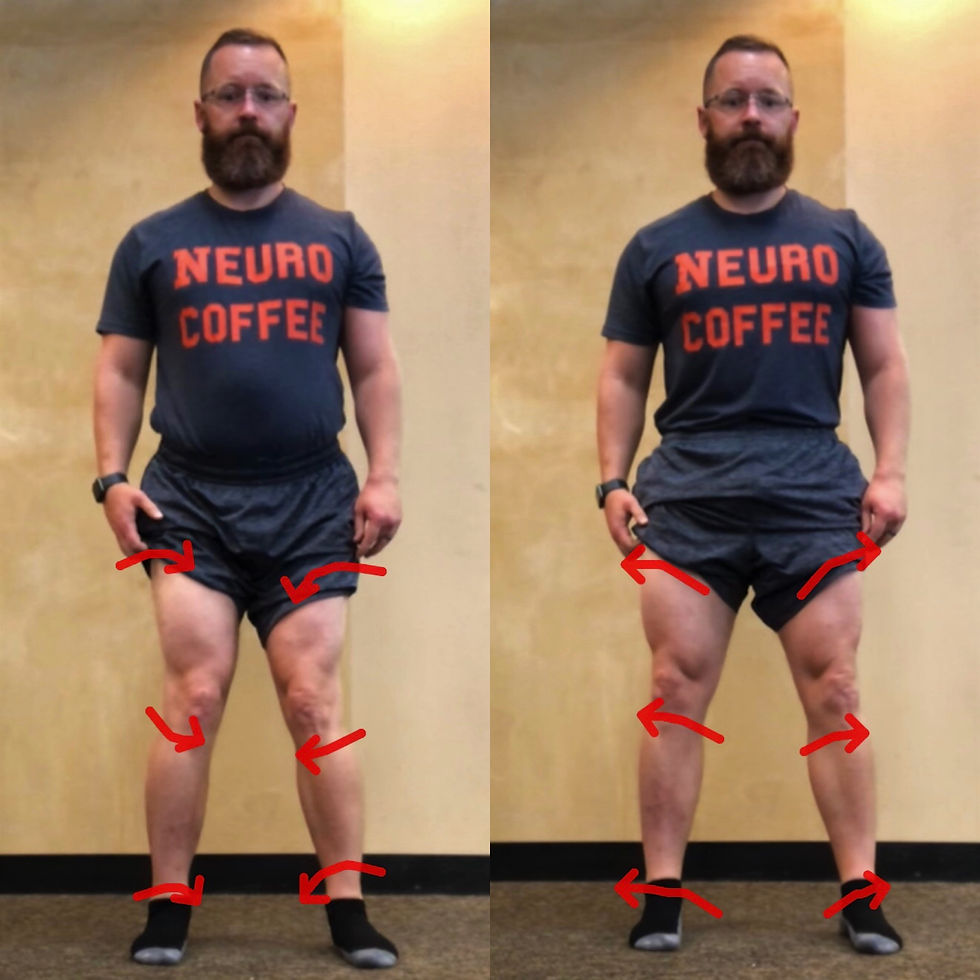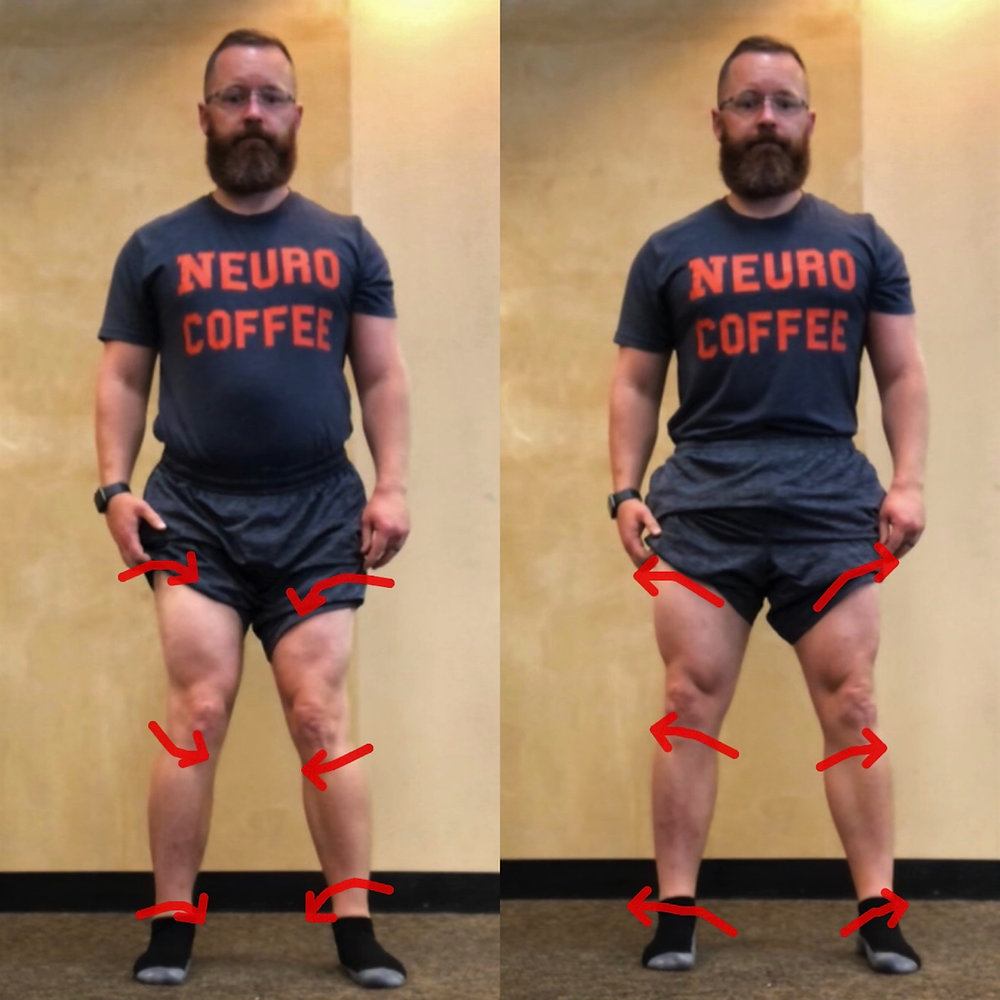
Please don’t shout “Knees Out!”
Whether you’re a fitness professional or a fitness fan, you have probably been versed in the concept that the “proper” cueing for the squat is “spread the floor with the feet and push the knees out.”
You’ve probably also heard “screw the feet out….keep your chest up…keep your head up…look up high…don’t let your knees go past the toes…don’t let you knees go in… etcetera, etcetera (these are obviously all the work of the devil).
I’m also sure that many of you have also used a band around the knees so that you reflexively push your knees outwards against the input of the band. The rationale for squatting this way usually involves the concept that you’re going to utilize more glutes and keep the knees in “alignment.”
(Just for full disclosure - I am guilty of using all of these early in my career too)
This is an accepted way to teach the squat and seems to be agreed upon by the people who are super strong, experienced lifters and coaches with the dirtiest of hands in the gym. This is also something utilized by prehab, rehab and injury mitigation folks as well.
Some of the most gifted athletes I’ve ever worked with who demonstrate great sports biomechanics and produce incredible amounts of force seem to show an action of the knees going towards midline during the upward portion of heavy squatting and jumping.
I’m here to attempt to show you that I don’t have any problem with the knees going inwards on the upward portion of a squat and to say that I may have an answer for you regarding why the best coaches, lifters and therapists have fallen so deeply in love with the spread the floor, knees out approach.
Argument explained: Mechanics
To explain my argument, I am going to walk you through concepts relating to natural lower body biomechanics and what joint force moments have to do with this approach.
I’ll also pass along some recommendations on what to do with this thought process and what assessment may be helpful with making determinations on what optimal squat mechanics may look like.
During any type of natural movement, our body must be able to both absorb and create force to move appropriately. The descent into the deep squat position would be the force absorption portion and pushing back up to standing would be the propulsive component of the squat pattern. The natural tendency of the femur during the descent would be to group flexion with abduction and external rotation (biased towards "knees out"). Conversely, during the concentric portion of the squat pattern, the natural tendency of the femur would be to group extension with adduction and internal rotation (biased towards "knees in").
This is an excellent strategy to use to save energy because the actions of flexion/abduction/ER would lead to lengthening of the extensors, adductors, and internal rotators of the lower body. This both maximizes the length-tension relationship of those tissues and provides a stretch reflex to assist the forthcoming ascent or concentric phase of the movement.
So, why cue the knees out so hard?
This cue likely came about due to coaches figuring out that “knees out” helped in the ability to squat heavy weights. However, the catch here is that heavily resistance-trained individuals seem to move differently, and you can definitely spot them walking. These individuals have developed their bodies to usually present with an anteriorly tilted pelvis more so than the general population.
When you tilt the pelvis forward, the femurs follow the forward tilt of the pelvis and orient internally and towards the middle of the body. If this person was unconscious, they would simply fall flat on their face due to the orientation of the pelvis and femurs. With a conscious human being in this position, they must battle gravity and prevent themselves from falling flat on their face. The typical response of an individual in this position while standing is that their femurs will reflexively start rotating outwards away from the middle of the body (external rotation/abduction) to maintain an upright position. This is the typical strategy that will be used by a heavily resistance trained individual to lift a heavy load.

Above: Anteriorly tilted pelvis (left) and Posteriorly tilted pelvis (right)
Where things really get interesting is when we lay this person on a table and measure hip range of motion.
When they lay down, they do not have to fight gravity and the femurs will stop their reflexive behavior of external rotation and abduction. This is the cause of why a majority of these people are lacking internal rotation and adduction of their hips - because the femur is already in an internally rotated and adducted position and cannot move any further in that direction.
This becomes a big problem when someone needs to come up from the bottom of a squat. The actions of adduction and internal rotation with hip extension are needed to be able to ascend from the bottom of a squat. So how do they obtain a motion that they do not have?
They must drive their knees further out (go further into abduction and external rotation) as they descend into the squat, so that they can then utilize “knees in” combined with hip extension when they drive upwards. They essentially have to “find” internal rotation.
The tricky part to this concept involves the area that revolves around injuries.
This is an area where people tend to get dazed and confused.

The mechanism of injury for an ACL tear is when the knee moves towards the middle of the body and rapidly rotates inwards. The catch though is that the injury to the ACL is based on the relationship of the femur to the tibia. There has to be a torque, twist, and a difference in direction between the femur and the tibia for this particular knee injury to happen.
If people are squatting and maintaining a flat foot with the weight evenly distributed throughout the foot, and the foot/heel/tibia complex is not rotating outwards during the descent, then witnessing the true actions of adduction and internal rotation of the thigh is probably not a cause for concern.
However, if you do see the lower leg rotating outwards while the thigh rotates inwards, this could be threatening to ligamentous and other soft tissue structures of the knee (particularly if there are high forces and velocities of movement involved).
Fully addressing the entire scope of injury mechanics is beyond the scope of this article; however, supposing that any observable movement of the knee towards the middle of the body is threatening, dangerous, likely wearing down soft tissues, and is undesirable is perhaps a rush to judgement on something that may be benign, so long as all parts of the lower body are synchronously working together in a fairly natural and stereotypical way for the human squat pattern.
There are two other specific topics that should be discussed before wrapping up this article:
Topic 1 – The Pelvis is the Key
The first is the topic of seeing medial translation during the descent of the squat. This would likely be indicative of someone who would be existing in the state of having an anteriorly tipped pelvis but is not kicking their femurs into the actions of externally rotation and abduction as their anti-gravity strategy. This is probably a highly untrained person, who is probably going to lack most of the desirable force production capabilities you’d look for in an athlete.
During the descent of the squat when the thighs should be flexing, abducting, and externally rotating, the pelvis should also be going into the direction of posterior rotation (to keep it simple) at the same time. If the pelvis is struggling with this moment and stays in the position of excessive anterior tilt, and the individual is not utilizing compensatory actions described above, you will definitely see a very unimpressive squat. This is undesirable, but we should begin the coaching process by trying to get the individual to gain better pelvic control first before trying to “coach up” the squat through cues trying to control the femur.
Topic 2 – Coaching Strategy
“Think twice and speak once or not at all” – Charlie Francis
When you start to think that you’re smarter than the millions upon millions of years of evolution, you’re starting to border on being someone who is either way too ego driven or ignorant in the depth of reality. Our bodies have a nervous system that has wired itself to figure out the most effective way to guide us through our complex environment.
A better way to coach someone would be to: Observe people for a while. Check your opinions at the door. Provide the feedback that the person needs but be careful about what you say and how you say it – be cautious and humble. Then let testing guide you (there will be workshops in the future on this topic, just ask me about those).
Second, if you want to figure out what the most energy efficient and effective squat would be, I recommend looking at it through EMG testing, but I wouldn’t try to see what the highest EMG would be. In fact, I would look for how I could get the lowest EMG for a squat. The least compensatory strategy, theoretically, would be the best and most efficient approach.
Concluding thoughts
In my opinion, the best way to perform the movement of squatting would feature performing the pattern in the mid-zone of abduction/adduction and internal/external rotation. If I want the least wear and tear over time, I would want to try to move through the middle of the pathway rather than forcing my way into the boundaries at each side.
So, I would not start coaching everyone to screw the floor out and push the knees out. I would use testing and a proper algorithm to decide a better squat position or implement to put them in a more optimal position to succeed.
In order to descend into the squat:
I would cue them to find and feel the middle of their heels.
Keep their heels at the bottom and find their big toe.
To push back up out of the squat:
I would have them continue to find and feel their heels and big toes
Then find and feel their medial arch
Then push through the medial arch to drive back up.
I then observe the behavior of their thighs with those cues for a while, continue to monitor how they respond on tables testing, progress them with load and reps and sets over time, and not think I necessarily always have the right answers.
Lastly, I wouldn’t treat everyone the same, and I’d be very careful about giving cookie cutter coaching cues to both individuals and groups.
Postscript (P.S.,):
This article does not necessarily consider the type of squat or implement used (i.e., body weight, back squat, front squat, goblet, split) but that will be another day for sure.
Most importantly
The degree to which a concept is entrenched in the collective working body of accepted beliefs can blind everyone in that field or with a particular exercise. To progress all available information, we should all avoid dogmatic thoughts and behaviors. Try to read and re-read this article, contact me and let’s discuss before you blow this off as crazy thoughts.
-1.png?width=129&height=50&name=Untitled%20design%20(24)-1.png)

Leave Your Comment
Many desktop publish packages web page editors now use model text
search for sites their infancy.